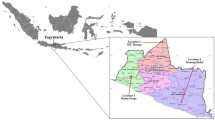Abstract
This paper presents the shrinkage cracking characteristics of cement treated demolition waste as a road base layer, which was produced by using recycled crushed concrete and masonry aggregates from construction and demolition waste (CDW). The developed method to estimate the crack pattern was based on the structural properties of cement treated demolition waste measured in the laboratory and the average climatic conditions recorded in the Netherlands. The influences of four mixture variables (masonry content, moisture content, cement content and degree of compaction) on the crack pattern were investigated. Results show that the proposed estimation model can predict the crack pattern of cement treated demolition waste comparable to the crack spacing observed in the field. The masonry variation in CDW is a key factor to determine its shrinkage cracking characteristics.






Similar content being viewed by others
Abbreviations
- CTB:
-
Cement treated base
- CDW:
-
Construction and demolition waste
- CTMiGr :
-
Cement treated recycled mix granulates with crushed recycled concrete and masonry
- RCA:
-
Recycled crushed concrete aggregates
- RMA:
-
Recycled crushed masonry aggregates
- UCS:
-
Unconfined compressive strength
- ITS:
-
Indirect tensile strength
- CTE:
-
Coefficient of thermal expansion
- C :
-
Cement content
- W :
-
Water content
- D :
-
Dry density
- DC:
-
Degree of compaction
- M :
-
Masonry content
- t :
-
Curing time
References
Rao A, Jha KN, Misra S (2007) Use of aggregates from recycled construction and demolition waste in concrete. Resour Conserv Recycl 50:71–81
Van Niekerk AA (2002) Mechanical behavior and performance of granular bases and sub-bases in pavements. PhD Thesis, Delft University of Technology, Delft
Hansen TC (1992) Recycling of demolished concrete and masonry. Report of Technical Committee 37-DRC, RILEM
Molenaar AAA (2005) Road materials—part I: cohesive and non-cohesive soils and unbound granular material for bases and sub-bases in roads. Lecture Notes CT 4850. Delft University of Technology, Delft
Xuan DX, Houben LJM, Molenaar AAA, Shui ZH (2011) Prediction of the mechanical properties of cement treated mix granulates. Paper presented at the TRB 90th annual meeting on CD, Washington, DC
Xuan DX, Houben LJM, Molenaar AAA (2012) Deformation behavior of cement treated recycled mix granulates. Paper presented at the TRB 91st annual meeting on CD, Washington, DC
Agrela F, Barbudo A, Ramírez A, Ayuso J, Carvajal MD, Jiménez JR (2012) Construction of road sections using mixed recycled aggregates treated with cement in Malaga, Spain. Resour Conserv Recycl 58:98–106
George KP (1968) Shrinkage characteristics of soil–cement mixtures. Highway Research Record 255, Washington, DC
Adaska WS, Luhr DR (2004) Control of reflective cracking in cement stabilized pavements. Paper presented at the 5th international RILEM conference, Limoges
Sebesta S (2005) Use of microcracking to reduce shrinkage cracking in cement treated Bases. Paper presented at the TRB 84th annual meeting compendium of papers DVD, Washington, DC
Penev D, Kawamura M (1993) Estimation of the spacing and the width of cracks caused by shrinkage in the cement-treated slab under restraint. Cem Concr Res 23(4):925–932
Lokhorst SJ (2001) Deformational behaviour of concrete influenced by hydration related changes of the microstructure. PhD Thesis, Delft Univeristy of Technology, Delft
Williams RIT (1986) Cement-treated pavements: materials, design, and construction. Elsevier Applied Science Publishers, London
Ni FJ, Li Q, Gu XY, Li ZX (2008) Prediction model for shrinkage cracking spacing of cement stabilized base. Paper presented at the TRB 87th annual meeting on CD, Washington, DC
Author information
Authors and Affiliations
Corresponding author
Rights and permissions
About this article
Cite this article
Xuan, D.X., Molenaar, A.A.A. & Houben, L.J.M. Shrinkage cracking of cement treated demolition waste as a road base. Mater Struct 49, 631–640 (2016). https://doi.org/10.1617/s11527-015-0524-7
Received:
Accepted:
Published:
Issue Date:
DOI: https://doi.org/10.1617/s11527-015-0524-7




